Lec 16 Exercise and Locomotion 1
1/105
There's no tags or description
Looks like no tags are added yet.
Name | Mastery | Learn | Test | Matching | Spaced |
|---|
No study sessions yet.
106 Terms
Sources of ATP in muscle cells
Creatine phosphate
Glycolysis
Oxidative Phosphorylation
Creatine phosphate
high-energy molecule that stores phosphate for very rapid (8-10 seconds) generation of ATP
Glycolysis
Produces 2 ATP per glucose, does not require oxygen, occurs in the cytoplasm, quick generation of ATP (lasts about 90 seconds)
Oxidative phosphorylation
Produces 36 ATP per glucose, requires oxygen, occurs in mitochondria, slow generation of ATP
Muscle Fiber Types
Slow oxidative (red fibers)
Fast oxidative (intermediate fibers)
Fast glycolytic (white fibers)
Myoglobin
_______ is what gives the muscle fiber it’s red color (as hemoglobin does in blood)
Slow Oxidative Fibers (Red Fibers)
These fibers are rich in myoglobin (which gives them their red color), and they rely on aerobic metabolism for energy.
They are slow to contract but can sustain contractions for a longer period.
These fibers are fatigue-resistant and are ideal for endurance activities, such as long-distance running.
Fast Oxidative Fibers (Intermediate Fibers)
These fibers are intermediate between slow oxidative and fast glycolytic fibers.
They are also involved in aerobic metabolism, but they have a faster contraction speed than slow oxidative fibers.
They are fatigue-resistant but can generate more power and contract faster than slow oxidative fibers.
Fast Glycolytic Fibers (White Fibers)
These fibers rely on anaerobic metabolism and have less myoglobin, which gives them a paler color.
They contract rapidly and with high power but are prone to fatigue quickly.
These fibers are used for short bursts of intense activity, such as sprinting or weightlifting.
speed/calcium
The ______ of tension/force generation is related to the dynamics of ______ regulation in the cell (how fast it can be pumped in and out of the cytoplasm).
ATP/decreases/sarcoplasmic reticulum
Studies suggest ____ is not usually the limiting factor for muscle fiber fatigue, but ______ in Ca2+ release from the _________ has been implicated in several studies
Velocity of shortening
How fast a muscle fiber can contract
Fast glycolytic fibers/force/power
________ fatigue more easily, but can generate more ______ and more _______ rapidly
Slow oxidative fibers/rapid/powerful
________ do not fatigue, but cannot generate ______ or very ________ contractions
velocity/myosin/ATPase
The _______ of contraction is related to the type of _______ expressed in the cell. Myosin isoforms differ in their _______ rate (the speed at which they can break down ATP)
red muscle/white muscle
In fish, there is _______ for slow, steady swimming and ________ for high-speed swimming (escape response)
Sympathetic/metabolic/proportions
When exercising, ________ nervous system activity increases. _______ rate increases (in muscle cells, liver, etc.). _______ of source of ATP changes over duration of exercise
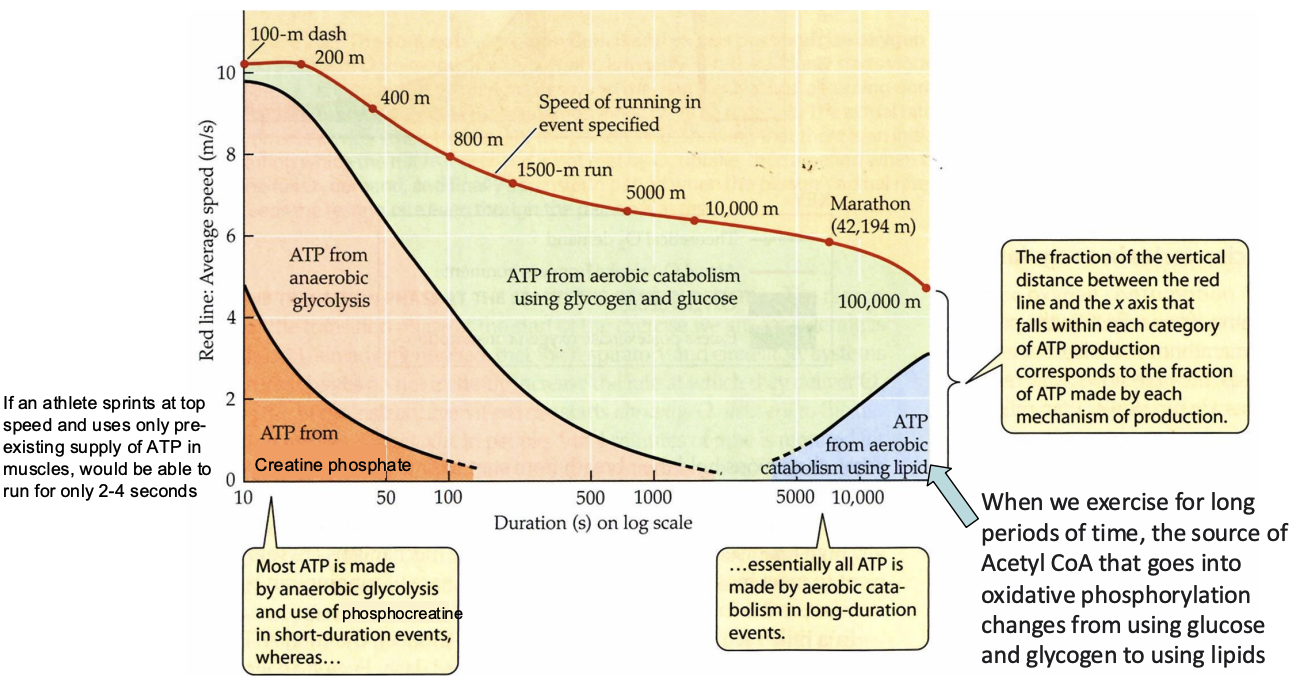
Acetyl CoA/lipids
When we exercise for long periods of time, the source of _________ that goes into oxidative phosphorylation changes from using glucose and glycogen to using ______
3-10x/blood flow
_____ increase in _______ to skeletal muscle when exercising
small to moderate/mean arterial pressure
______ increase in ________ when exercising (93mmHg to 113mmHg ish)
vasodilation
When exercising, ________ occurs (particularly to skeletal muscle→ decreased resistance)
EDV/stroke volume/heart rate/2-6x/cardiac output
When exercising: due to ______ increasing, along with ______ (can be up to 50%), and a 2-3x increase in ________, there is a total ____ increase in ________
brain/absolute/rest
When exercising, the proportion of blood to the ____ is less, but the _______ amount of blood is slightly higher than at ______
heart/skeletal muscle/skin
During exercise, more blood is sent to the _____, _______, and ___
gut/kidney
During exercise, less blood is sent to the _____ and _____
ventilation/rate/depth/20x/alveolar
When exercising _______ increases: Breathing _____ and _____ increase (up to _____ increase in the _______ ventilation rate)
Pulmonary capillaries
When exercising, an acute changes in ventilation is the _______ dilating
cardiovascular delivery of oxygen
While ventilation and oxygen consumption increase during exercise, the ________________ becomes the limiting factor for performance, especially at higher intensities.
VO2 max
Maximal rate of oxygen consumption by the body (aerobic capacity)
cardiovascular
In athletes, VO₂ max is often higher because they have more efficient _________ systems, able to deliver oxygen more effectively to the muscles.
enzymes/oxidative phosphorylation
In response to endurance training, there’s an increased expression of ________ involved in _________
mitochondrial density/lipid droplets/fiber
In response to endurance training, there’s an increase in _________ and _________ which is consistent with switch in _____ type (more oxidative type)
activity
The proportion of people’s muscle fiber types varies by _______ level
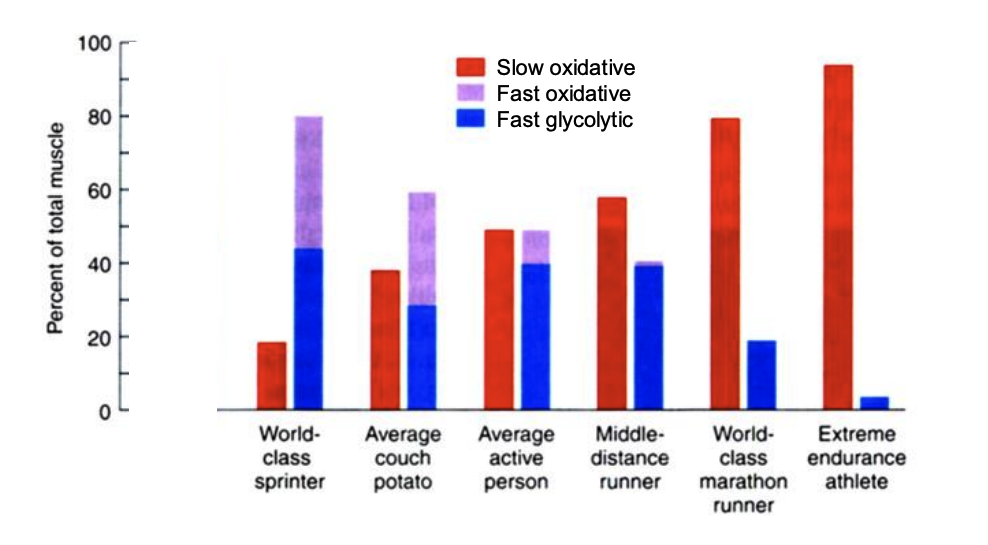
muscles/skeleton
Movement requires ______ exerting a force on a ________ (supporting structures of body)
types of skeletons
1) Endoskeleton
2) Exoskeleton
3) Hydrostatic skeleton
Endoskeleton
a hard internal skeleton
vertebrates/cartilage/bone
Endoskeletons are typical for ________ (e.g. fish, amphibians, reptiles, birds, mammals). They can be made of ______ or ____ (primitive vertebrates, including lampreys and sharks have skeletons that are 100% cartilage)
antagonistic
In endoskeletons, muscles are arranged in ________ pairs
Examples of Antagonistic Muscles
Biceps and triceps.
Gluteus maximum and hip flexors.
Hamstrings and quadriceps.
Pectoralis major and latissimus dorsi.
Gastrocnemius and tibialis anterior.
Abductor and adductor.
Exoskeleton
a hard external skeleton
invertebrates
An exoskeleton is typical for some _________ (e.g. insects, crustaceans).
Cuticle
Hard, secreted outer layer of the exoskeleton, made primarily of chitin (a polysaccharide), along with protein and lipids.
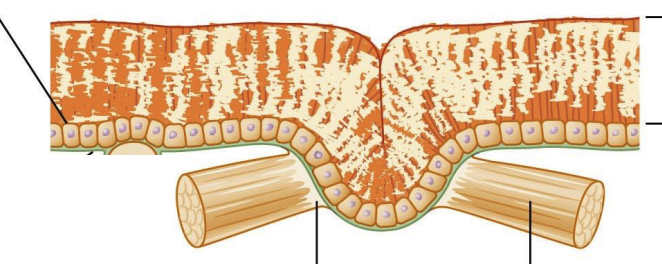
Hypodermis
Cellular layer, secretes chitin, protein, lipids that make up cuticle
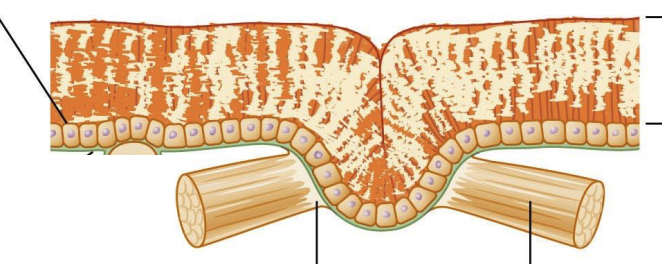
Myotendon Junction
Sites at which muscles connect to exoskeleton

Hydrostatic skeleton
Type of skeleton found in many soft-bodied animals that uses fluid-filled cavities within the body to provide support and enable movement. These cavities, under pressure, allow muscles to contract against a fluid, creating movement or maintaining shape.
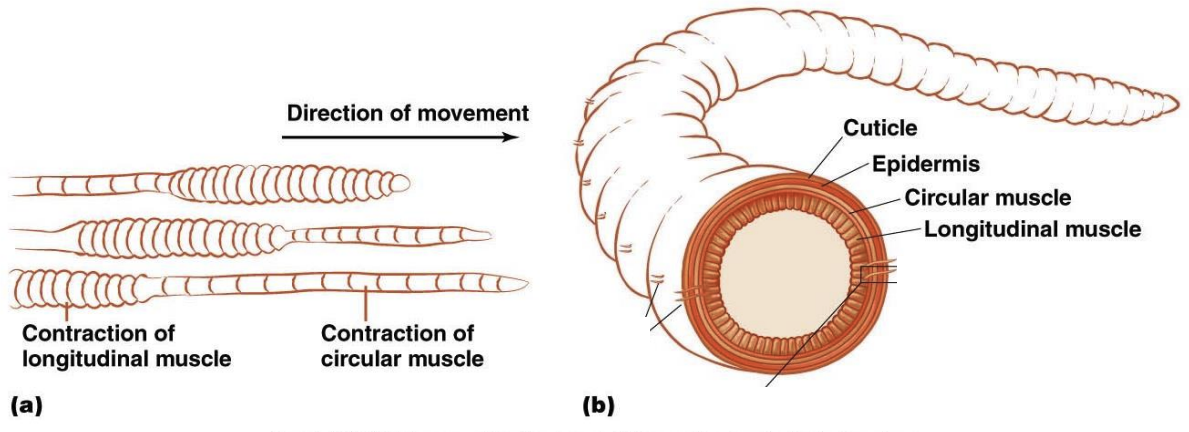
incompressible fluid/internal
In a hydrostatic skeleton, muscles move _________ through ________ compartments to achieve movement.
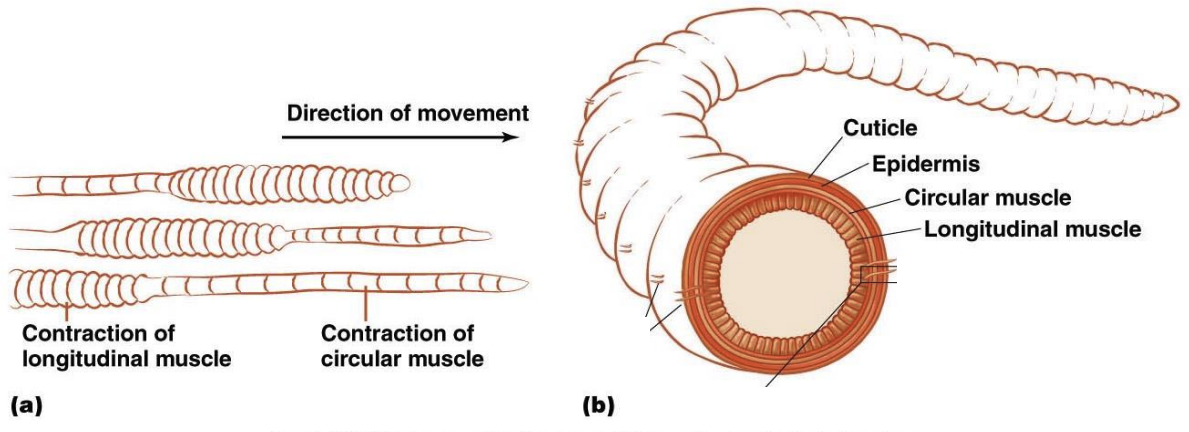
invertebrates
Hydrostatic skeletons are found primarily in ________ (e.g. leeches, earthworms, squids).
Cuticle/epidermis/circular muscle/longitudinal muscle
Layers of the hydrostatic skeleton from outermost to innermost
Fluid mechanics
the physics of fluids (gases and liquids, i.e. air and water)
Reynolds Number/inertial forces/viscous forces
The ______ is a dimensionless ratio that compares the relative effects of _______ (tendency of an object to keep moving) to ______ (friction from the fluid) acting on an organism moving through a fluid (like water or air).
fluid/size/shape
The Reynolds number (Re) reflects the properties of the _____ and the _____ and ______ of the animal.
VLp/u
Formula for Reynolds number
velocity of movement/linear dimension of animal/density of fluid/viscosity of fluid
Reynolds number is calculated by multiplying the _____, _____, and ______. Then dividing by the ________
sizes/environments
The Reynolds number helps explain how organisms of different _____ and ________ move efficiently
speed/momentum
At high Re, creatures rely on ______ and ______ (inertial forces have greatest influence on locomotion)
resistance/propulsion
At low Re, creatures must cope with ______ and use different ______ strategies. (viscous forces have the greatest influence on locomotion)
Velocity/flow
_______ of the fluid relative to the object affects ____ (laminar vs tubulent)
increased
A denser fluid means _______ energetic cost of movement
laminar
A slow velocity of fluid means _____ flow
turbulent
A fast velocity of fluid means _____ flow
Turbulence
_________ increases the energetic cost of locomotion
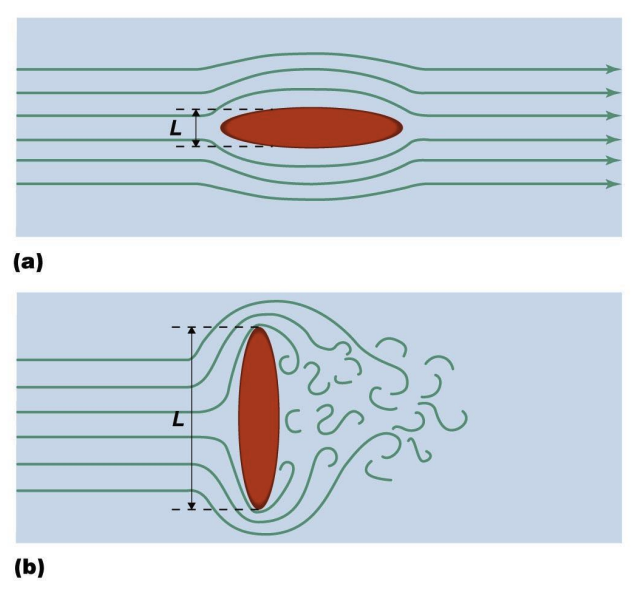
orientation
The _________ of an organism affects the formation of turbulence
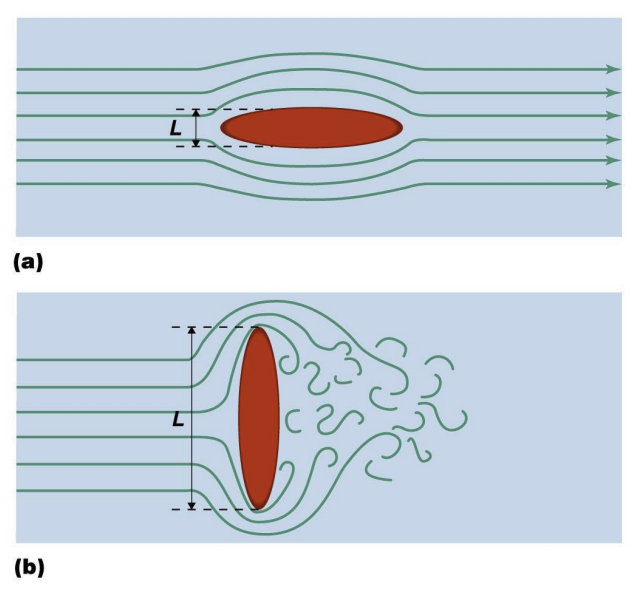
Boundary layers
Regions where the fluid flow slows down due to friction between the fluid and the object's surface
same
With low viscosity there is much less friction between the fluid and the animal → the layers of the fluid will move at the _____ rate.
velocity
Boundary layers (resulting from higher viscosity / increased friction) reduce the _______ of an object and increases energetic costs of movement
higher
Larger animals have _______ Reynolds numbers than small animals
High Re
Inertial forces dominate.
Organisms are generally larger or moving faster.
Momentum carries them forward.
Low Re
Viscous forces dominate.
Organisms are very small or moving slowly.
Movement is heavily resisted by fluid viscosity, so inertia is negligible.
drag
streamlining reduces _____
streamlining
design or provide with a form that presents very little resistance to a flow of air or water, increasing speed and ease of movement.
Friction drag
Drag that results from the interaction between the fluid and object.
Occurs when the layers of fluid near the object's surface move at different speeds.
This type of drag increases with the roughness of the surface and is reduced by making the object's surface smooth.
Pressure drag
Force required to redirect the fluid around the object. It occurs when fluid has to change direction to flow past the object, creating a low-pressure zone behind the object.
Streamlining the object (making it more tapered) reduces the size of the low-pressure zone, thereby reducing this type of drag
Fish/tail/swirling vortices
______ generate forward propulsion by moving ____ side to side: generates ________ that provide force for forward movement
Buoyancy
Increased ________ can decrease the cost of locomotion in water
fat/air
____ and ___ are both less dense than water
gas/bladders
_____ filled swim _______ increase buoyancy – decrease the cost of swimming
barnacle/lipid
To increase buoyancy, _______ larva have _____ droplets
fat
To increase buoyancy, aquatic mammals have ___ that also helps with insulation
Swim Bladders
gas-filled organs that help fish regulate their buoyancy in the water
Types of Swim Bladders
Physoclist swim bladder
Physostome swim bladder
Physosclist swim bladder
This type of swim bladder can control the volume of gas in the swim bladder by moving gases between the gas gland and the oval (a part of the swim bladder).
Gas is added through the gas gland, and gas can escape through the oval window.
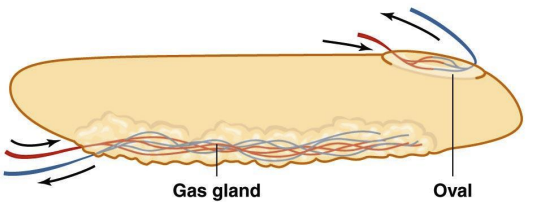
Physostome swim bladder
The gas in this type of swim bladder is controlled through a pneumatic duct that connects the swim bladder to the esophagus.
Fish with this type can gulp air to fill their swim bladder or release gas through the same duct to deflate it.

Antagonism
There is _______ of Muscles During Bird Flight
pectoralis
For the downstroke of bird flight, the _______ muscle is important
Supracoracoideus
For the upstroke of bird flight, the _______ muscle is important
contracts/relaxes
On the downstroke, the pectoralis muscle _______, while the supracoracoideus _______, and vice versa

hover/upstroke/supracoracoideus
Hummingbirds _______ a lot so they use _______ more frequently, so larger ___________ muscle
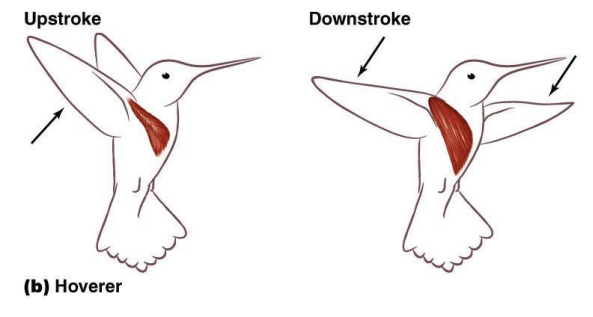
Bernoulli’s Principle
a faster moving fluid produces less pressure than the same fluid moving at a slower speed
faster/pressure/slower/pressure/lift
The shape of the bird's wing (airfoil) creates a situation where ______ air flow on top reduces _______, while ______ air flow beneath increases _______, producing ____
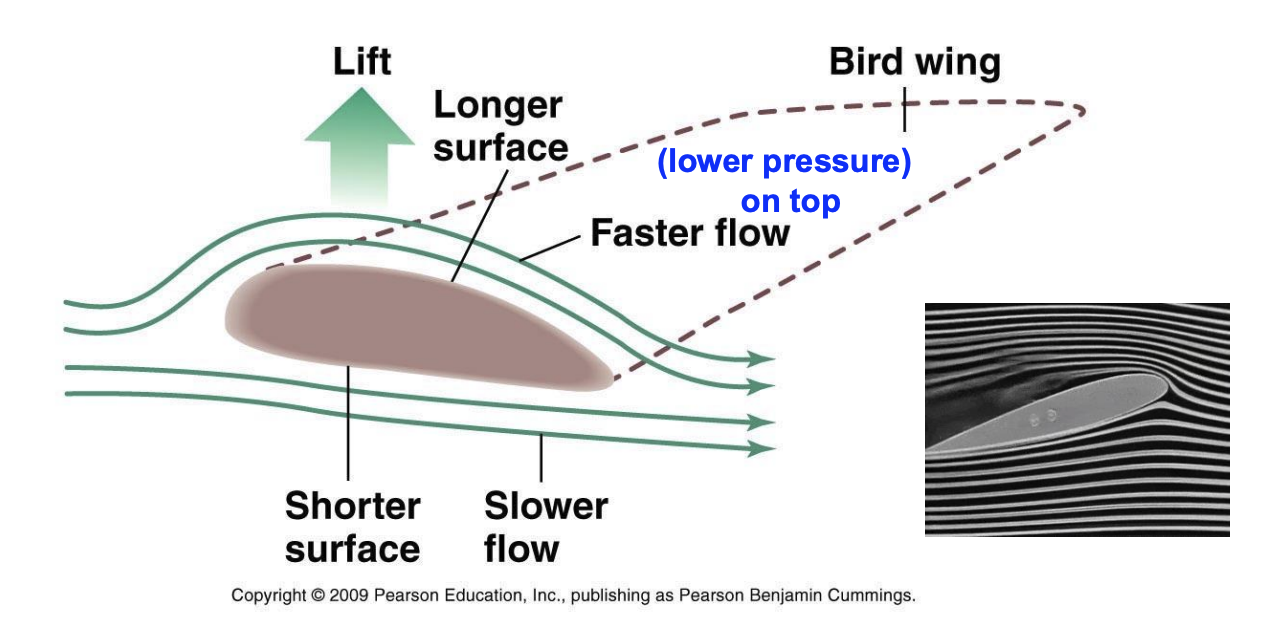
Wing Loading
weight of the bird divided by the bird’s wing area
High/speeds/maneuverability
____ wing loading is efficient and advantageous for high ______, but reduces _________
types of muscle attachment for flight in insects
Direct muscles
Indirect muscles
Direct muscles
direct connection between muscles and wings

Indirect muscles
Attached to cuticle on body (flatten vs. expand entire body to move wings)

Indirect/direct
______ muscles (40-1000/sec) lead to higher wingbeat frequencies than _______ muscles (20-40/sec)
Synchronous flight muscles
Contraction initiated by an Action Potential
Generate one contraction for one Action Potential
Contraction and relaxation requires a Ca2+ transient: relaxation can only happen as fast as Ca2+ can be removed from cytoplasm.
This requires lots of ATP to run the SERCA pumps to put Ca2+ back in the sarcoplasmic reticulum.
Found in insects with larger wings and wingbeat frequencies less than 100 beats per second like dragonflies, moths and butterflies
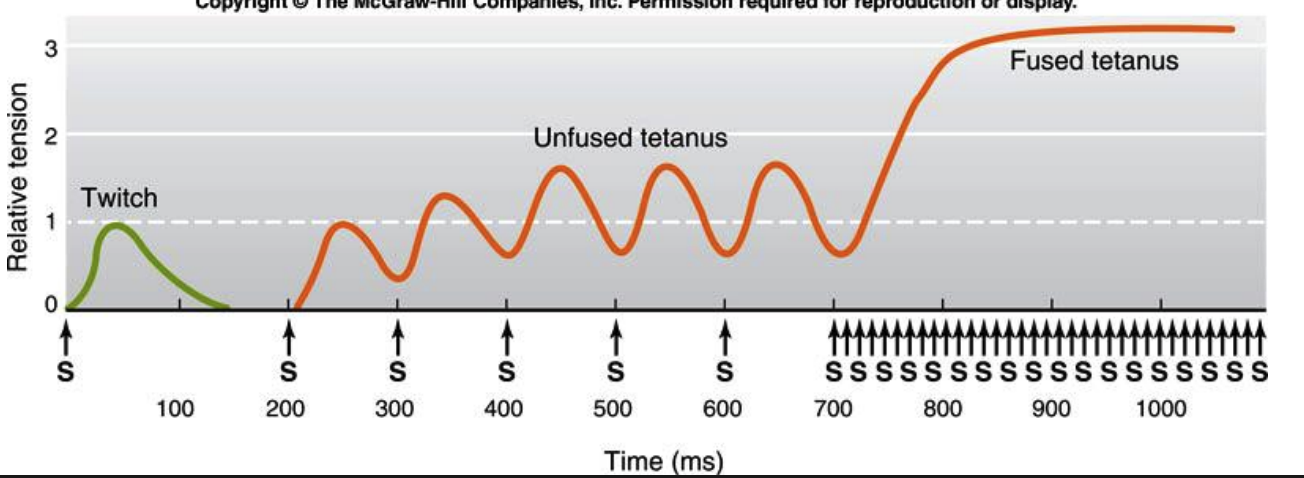
action potential
In both synchronous and asynchronous flight muscles, contraction is initiated by an __________
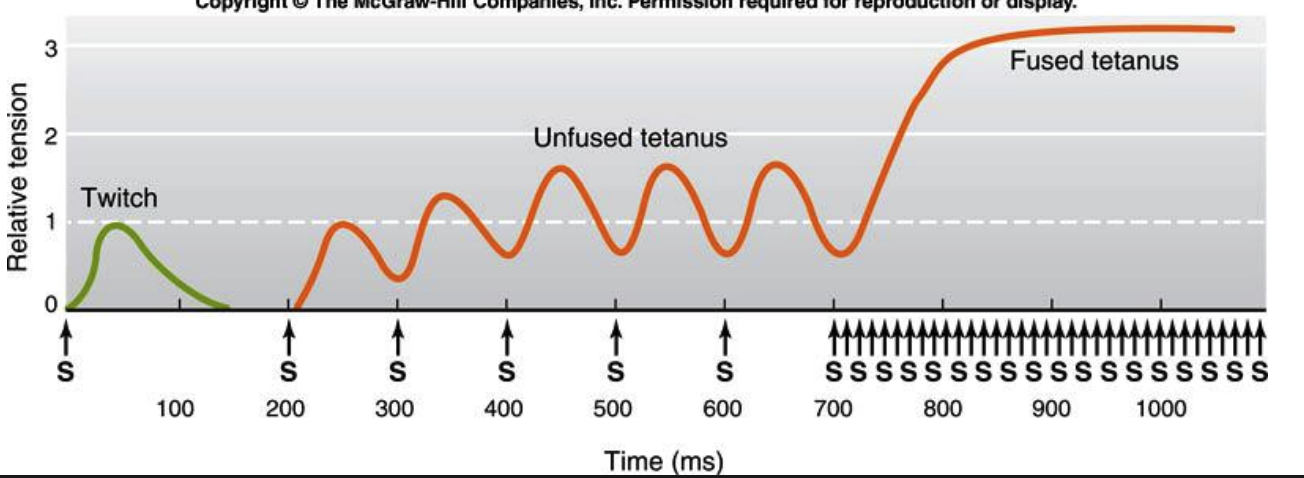
one contraction/one action potential
In synchronous flight muscles, you generate __________ for _________

Ca2+ transient/removed
In synchronous flight muscles, contraction and relaxation requires a _______: relaxation can only happen as fast as Ca2+ can be ________ from cytoplasm. This requires lots of ATP to run the SERCA pumps to put Ca2+ back in the sarcoplasmic reticulum.
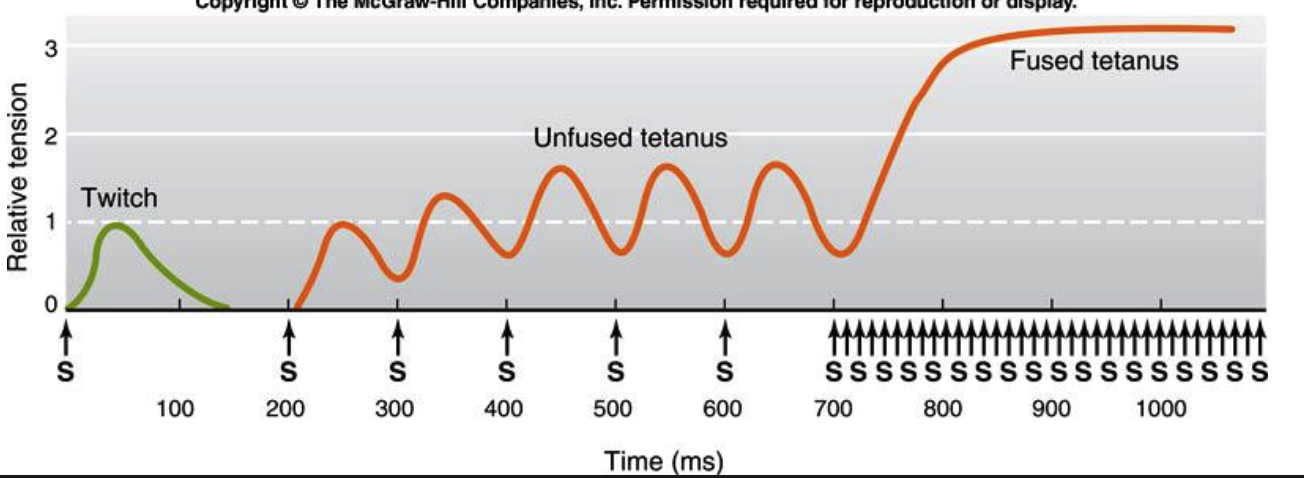
larger/100
Synchronous flight muscles are found in insects with _______ wings and wingbeat frequencies less than ____ beats per second like dragonflies, moths and butterflies